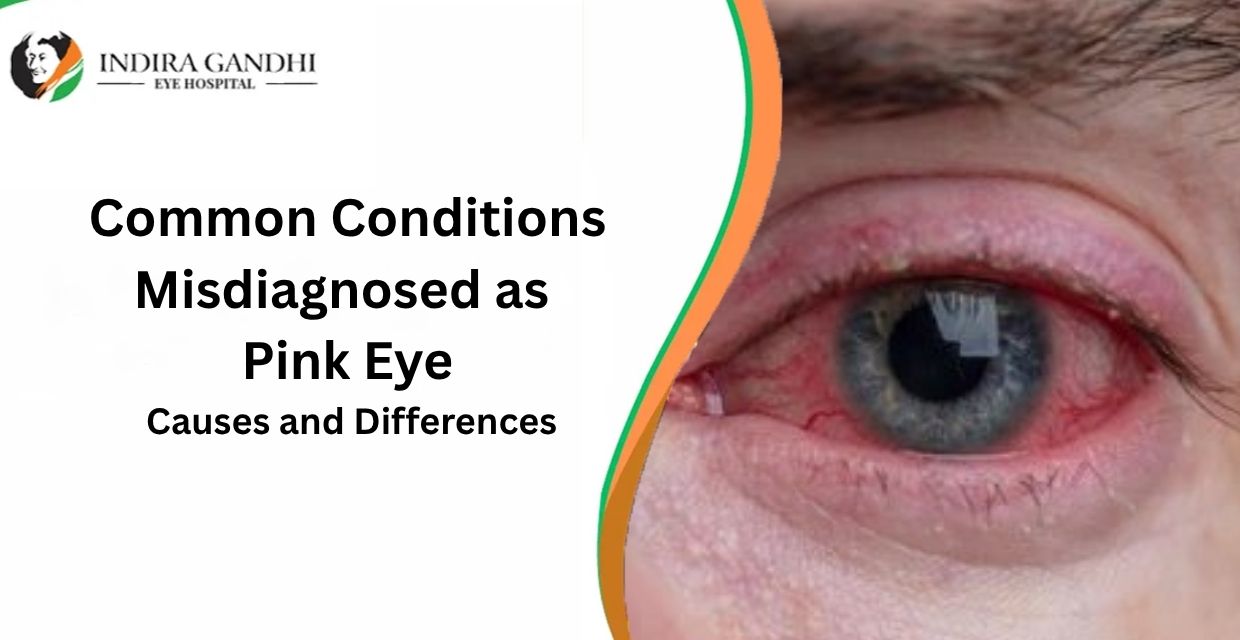|
Getting your Trinity Audio player ready...
|
As an experienced ophthalmologist with over two decades of clinical practice, I encounter countless patients daily who arrive at my clinic absolutely convinced they’re suffering from pink eye, only to discover they’re actually dealing with a completely different ocular condition. The critical question “What is commonly misdiagnosed as pink eye?” emerges in nearly every consultation session, and this misconception represents far more than just a simple diagnostic error—it can potentially lead to delayed treatment protocols, progressive symptom deterioration, and, in severe cases, irreversible vision damage that could have been completely preventable.
Pink eye, scientifically termed conjunctivitis, unfortunately shares numerous overlapping symptoms with various other serious eye conditions, creating a complex diagnostic challenge that even seasoned healthcare professionals occasionally encounter in their practice. Understanding precisely what is commonly misdiagnosed as pinkeye becomes absolutely crucial for both patients seeking answers and medical practitioners striving to provide optimal care while preventing dangerous complications.
Understanding Pinkeye: The Diagnostic Foundation
Pinkeye fundamentally represents inflammation of the conjunctiva—the delicate, transparent membrane covering the white portion of your eye and lining the inner surfaces of your eyelids. This prevalent condition manifests through several unmistakable symptoms that patients frequently recognize from previous experiences, unfortunately leading many individuals toward premature self-diagnosis.
Characteristic pink eye symptoms include:
- Persistent redness affecting one or both eyes simultaneously
- Intense itching or burning sensations throughout the day
- Watery discharge that progressively becomes thick and crusty
- Excessive tear production beyond normal levels
- Heightened sensitivity to bright lights and sunshine
- Persistent gritty feeling resembling trapped sand particles
- Notable swelling of eyelids and surrounding facial tissue
- Morning crusting that temporarily seals eyelids shut
However, these distinctive symptoms demonstrate significant overlap with numerous other potentially serious ocular conditions, which directly explains why comprehensively understanding what is commonly misdiagnosed as pinkeye becomes absolutely essential for proper eye care management and timely intervention.
The Top 10 Conditions: What Is Commonly Misdiagnosed as Pink Eye
1. Blepharitis: Chronic Eyelid Inflammation
Blepharitis consistently ranks among the most frequently encountered conditions when discussing common misdiagnoses of pink eye in clinical practice. This persistent inflammatory condition specifically affects the eyelid margins and associated oil glands, producing troublesome symptoms that closely mimic traditional conjunctivitis presentations.
Distinctive Blepharitis Features:
- Extensive crusting and scaling along the eyelash base
- Chronic, recurring nature lasting weeks or months
- Dandruff-like flakes stubbornly adhering to eyelashes
- Burning sensation significantly more pronounced than itching
- Morning symptoms consistently worse than evening presentations
2. Dry Eye Syndrome: The Modern Digital Epidemic
In our increasingly digitally focused society, dry eye syndrome has become dramatically more prevalent, frequently leading concerned patients to question whether it is commonly misdiagnosed as pink eye. This debilitating condition develops when natural tear production decreases substantially or tear quality deteriorates significantly.
Key Dry Eye Characteristics:
- Paradoxical excessive tearing as a compensatory mechanism
- Symptoms dramatically worsen in air-conditioned environments
- Persistent, gritty, sandy sensation without infectious discharge
- Discomfort significantly increases with prolonged screen exposure
- Frequent blinking provides temporary symptomatic relief
3. Allergic Conjunctivitis: The Seasonal Imitator
Allergic conjunctivitis frequently confuses patients desperately seeking answers about what is commonly misdiagnosed as pink eye. While technically representing a specific form of conjunctivitis, its underlying pathological mechanism and appropriate treatment protocols differ dramatically from infectious varieties.
Distinguishing Allergic Factors:
- Bilateral involvement affecting both eyes simultaneously
- Distinct seasonal patterns correlating with environmental allergen exposure
- Accompanying nasal congestion and frequent sneezing episodes
- Intense itching as the predominantly overwhelming symptom
- Clear, watery discharge completely lacking purulent characteristics
4. Subconjunctival Hemorrhage: The Alarming Red Appearance
The sudden, dramatic appearance of bright red blood pooling on the eye’s surface often prompts panicked patients to urgently question what is commonly misdiagnosed as pink eye. Subconjunctival hemorrhage, despite its visually alarming presentation, differs significantly from standard conjunctivitis.
Characteristic Hemorrhage Features:
- Sudden onset with distinct, well-demarcated red blood pooling
- Complete absence of pain, discharge, or vision changes
- Often discovered incidentally by concerned family members
- May follow vigorous coughing, sneezing, or physical straining
- Self-resolving over one to two weeks without intervention
5. Keratitis: The Vision-Threatening Emergency
Keratitis represents one of the most potentially devastating conditions when considering what is commonly misdiagnosed as pink eye. This serious corneal infection or inflammation demands immediate, aggressive medical intervention to prevent permanent, irreversible vision loss.
Critical Keratitis Warning Signs:
- Severe, sharp eye pain far exceeding typical conjunctivitis discomfort
- Significant vision reduction affecting daily functional activities
- Extreme light sensitivity requiring completely darkened environments
- Visible corneal opacity or clouding detectable during examination
- History of contact lens wear or recent eye trauma
6. Iritis: The Deep Ocular Inflammation
Iritis frequently emerges in clinical discussions about what is commonly misdiagnosed as pink eye due to concerning symptom overlap. This serious inflammation of the iris requires specialized treatment protocols to prevent dangerous complications.
Distinguishing Iritis Characteristics:
- Deep, persistent aching eye pain rather than surface irritation
- Circumcorneal injection with redness concentrated around the cornea
- Severe photophobia requiring sunglasses even indoors
- Progressive blurred vision significantly affecting daily activities
- Potential associations with systemic autoimmune conditions
7. Acute Angle-Closure Glaucoma: The Medical Emergency
While relatively rare, acute angle-closure glaucoma occasionally appears in discussions about what is commonly misdiagnosed as pink eye. This condition represents a true medical emergency requiring immediate intervention within hours.
Emergency Glaucoma Indicators:
- Severe eye pain accompanied by simultaneous intense headache
- Nausea and vomiting directly accompanying eye symptoms
- Distinctive halos visible around all light sources
- Rapid symptom onset developing over just a few hours
- Dramatic vision reduction affecting functional ability
Comprehensive Diagnostic Comparison
| Condition | Primary Symptoms | Key Differences | Treatment Urgency |
| Blepharitis | Eyelid crusting, burning sensation | Chronic course, lash debris | Routine management |
| Dry Eye Syndrome | Grittiness, excessive tearing | No infectious discharge | Non-urgent care |
| Allergic Conjunctivitis | Bilateral itching, clear discharge | Seasonal patterns | Symptomatic relief |
| Subconjunctival Hemorrhage | Bright red blood patch | No pain, sudden onset | Observation only |
| Keratitis | Severe pain, vision loss | Corneal involvement | URGENT |
| Iritis | Deep pain, photophobia | Circumcorneal redness | URGENT |
| Acute Glaucoma | Severe pain, halos | Systemic symptoms | EMERGENCY |
The Critical Importance of Professional Diagnosis
I consistently emphasize that accurate diagnosis absolutely requires professional evaluation utilizing specialized equipment and extensive clinical expertise. Inappropriate self-diagnosis and inadequate treatment can potentially lead to serious complications.
Potential Misdiagnosis Complications:
- Significantly delayed appropriate treatment causing unnecessary symptom prolongation
- Dangerous progression of serious conditions like keratitis to permanent corneal scarring
- Inappropriate antibiotic overuse contributing to growing resistance patterns
- Missed critical opportunities for early intervention in glaucoma cases
- Chronic conditions becoming increasingly difficult to manage effectively
The best eye hospital in India consistently employs comprehensive diagnostic protocols, including advanced slit-lamp biomicroscopy, specialized fluorescein staining, precise intraocular pressure measurement, and detailed patient history evaluation to ensure completely accurate diagnoses.
Emergency Warning Signs Requiring Immediate Care
Understanding misdiagnosed pinkeye effectively helps patients recognize when immediate professional evaluation becomes absolutely necessary.
Critical Red Flag Symptoms:
- Eye pain significantly exceeding mild discomfort levels
- Substantial vision changes or noticeable reduction
- Severe light sensitivity requiring completely darkened rooms
- Symptoms rapidly worsening despite initial treatment attempts
- Associated systemic symptoms, including fever or nausea
- History of eye trauma or dangerous chemical exposure
Prevention Strategies for Optimal Eye Health
While understanding what is commonly misdiagnosed as pinkeye remains important, implementing effective prevention strategies represents the optimal approach:
Essential Preventive Measures:
- Maintain absolutely strict hand hygiene, especially before touching eyes
- Follow proper contact lens care protocols religiously and consistently
- Use appropriate protective eyewear in potentially hazardous environments
- Manage underlying allergies with prescribed medications effectively
- Schedule regular comprehensive eye examinations with qualified specialists
- Avoid sharing personal eye care items with other individuals
Expert Recommendations for Long-Term Eye Health
Based on decades of extensive clinical experience treating patients who initially if they were commonly misdiagnosed as having pinkeye, I strongly recommend
Professional Clinical Guidelines:
- Never automatically assume eye redness indicates simple pinkeye
- Seek immediate professional evaluation for persistent symptoms beyond 48 hours
- Avoid over-the-counter treatments without proper professional diagnosis
- Maintain regular eye examinations even without obvious symptoms
- Report any sudden vision changes immediately to qualified specialists
Conclusion: Expert Eye Care Excellence
Understanding precisely what is commonly misdiagnosed as pinkeye represents just the beginning of comprehensive eye health management. The inherent complexity of various ocular conditions requires professional expertise, advanced diagnostic equipment, and comprehensive treatment approaches that only specialized eye care facilities can adequately provide.
The best eye hospital in India expertly combines experienced ophthalmologists, state-of-the-art diagnostic technology, and comprehensive treatment protocols to ensure accurate diagnosis and optimal patient outcomes. When facing persistent eye symptoms that might initially appear like simple pinkeye, professional evaluation becomes absolutely essential for protecting precious vision and maintaining excellent long-term eye health.
For patients seeking exceptional eye care with accurate diagnostic capabilities, Indira Gandhi Eye Hospital stands as a premier institution offering comprehensive ophthalmologic services throughout India. Their experienced team of specialists utilizes advanced diagnostic protocols to effectively differentiate between conditions commonly mistaken for pinkeye. ensuring appropriate treatment for each patient’s specific needs. Indira Gandhi Eye Hospital expertly combines decades of clinical expertise with cutting-edge modern technology to provide the highest possible standard of eye care for patients.
FAQs: Common Conditions Misdiagnosed as Pink Eye
What is the difference between pink eye and blepharitis?
Pink eye (conjunctivitis) affects the eye’s surface, causing redness and discharge. In contrast, blepharitis primarily affects the eyelids, leading to crusting and scaling around the eyelashes. While both can cause irritation, blepharitis is often more chronic and associated with flakes in the lashes.
How can I tell if my eye irritation is due to dry eyes or pink eye?
Dry eye syndrome often causes a gritty or sandy feeling without any infection-related discharge. The eyes may tear excessively as a compensatory mechanism, but there’s no thick, yellow discharge like in conjunctivitis. Dry eyes can also worsen with prolonged screen time, while pink eye typically involves more noticeable redness and discharge.
Is allergic conjunctivitis the same as pink eye?
No, allergic conjunctivitis is caused by allergens (e.g., pollen, dust) and often leads to itching, watery discharge, and redness in both eyes. Pink eye, typically an infection, may cause thicker discharge and has an infectious cause. Allergic conjunctivitis is treated with antihistamines, while pink eye may require antibiotics or other treatments.
Can I get acute angle-closure glaucoma mistaken for pink eye?
Yes, acute angle-closure glaucoma can sometimes be mistaken for pink eye because it causes eye redness and discomfort. However, glaucoma is associated with severe eye pain, nausea, vomiting, and halos around lights. This condition requires immediate medical attention as it can lead to permanent vision loss.












